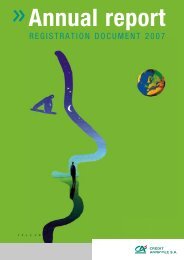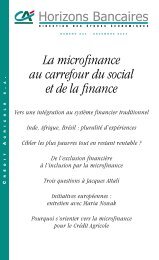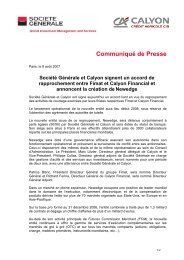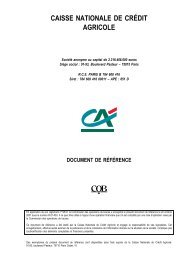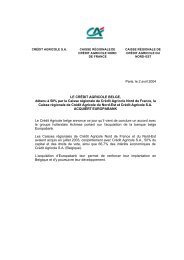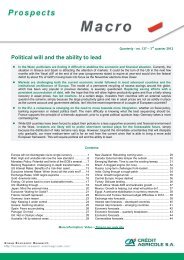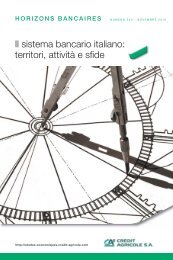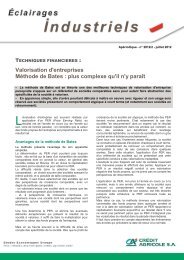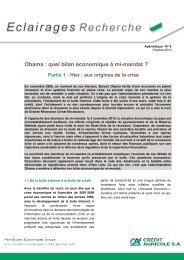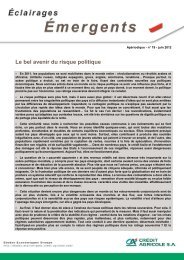PDF (3.77 Mo) - Le Crédit Agricole
PDF (3.77 Mo) - Le Crédit Agricole
PDF (3.77 Mo) - Le Crédit Agricole
Create successful ePaper yourself
Turn your PDF publications into a flip-book with our unique Google optimized e-Paper software.
Crédit <strong>Agricole</strong> S.A.Update of the 2011 registration document - A03Shareholders’ equityAt 30 June 2012, Crédit <strong>Agricole</strong> S.A.'s shareholders' equity (before deduction of equity investments)amounted to €38.6 billion (compared with €40.4 billion at 31 December 2011). The main changes were due i)to the buyback and call of super-subordinated securities and ii) to the variation in unrealised gains andlosses.Total regulatory capital (before deduction of equity investments) amounted to €60.2 billion, comparedwith €62.4 billion at 31 December 2011.Solvency ratiosRegulations in forceThe decree of 20 February 2007, amended on 23 November 2011, transposing the European CapitalRequirements Directive (CRD III) into French law, defined the “capital requirements applicable to creditinstitutions and investment firms”. In accordance with these provisions, Crédit <strong>Agricole</strong> S.A. Group hasincorporated the impacts of the implementation of this directive into the management of its capital and itsrisk.The CRD ratio is mandatory as of 1 January 2008. However, banks continue to calculate the CAD ratio, asthe regulatory authority has defined a floor of 80% of these requirements until at least 31 December 2011,and for information only in 2012.The capital adequacy ratio, which is calculated in accordance with the rules set out in the European CRD 3directive, is based on the assessment of weighted assets of credit risk, of market risks and of operationalrisk. The resulting capital requirements for each type of risk are set out below in the paragraph entitled“Capital requirements by type of risk”.In accordance with the decree of 20 February 2007, exposure to credit risk is measured using two methods:- the standardised approach, which is based on external credit ratings and fixed weightings for eachBasel exposure class;- the internal ratings based approach (IRB), which is based on the bank’s own internal rating system.There are two subsets of the IRB approach:ooFoundation IRB (IRB-F): banks may only use their own estimates of default probability,Advanced IRB (IRB-A): banks use their own estimates of all risk components, includingprobability of default, loss given default, exposure at default and maturity.In late 2007, the French Regulatory Control Authority authorised Crédit <strong>Agricole</strong> S.A. Group to use itsinternal rating systems to calculate regulatory capital requirements for credit risk on retail and corporateexposures across most of its scope.In addition, the French Regulatory Control Authority authorised Crédit <strong>Agricole</strong> S.A. Group to use theadvanced measurement approach (AMA) to calculate operational risk capital requirements for its mainentities as of 1 January 2008. The other Group entities use the standardised approach, in accordance withregulations.Page 97 sur 237



